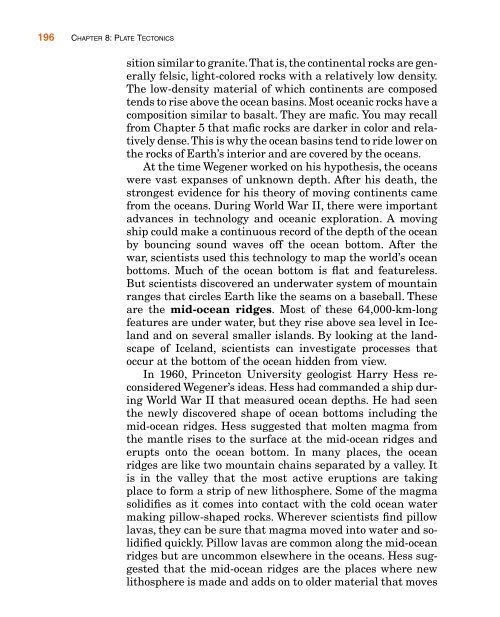Chapter 8 Plate Tectonics
Chapter 8 Plate Tectonics
Chapter 8 Plate Tectonics
You also want an ePaper? Increase the reach of your titles
YUMPU automatically turns print PDFs into web optimized ePapers that Google loves.
196 CHAPTER 8: PLATE TECTONICS<br />
sition similar to granite.That is, the continental rocks are generally<br />
felsic, light-colored rocks with a relatively low density.<br />
The low-density material of which continents are composed<br />
tends to rise above the ocean basins. Most oceanic rocks have a<br />
composition similar to basalt. They are mafic. You may recall<br />
from <strong>Chapter</strong> 5 that mafic rocks are darker in color and relatively<br />
dense.This is why the ocean basins tend to ride lower on<br />
the rocks of Earth’s interior and are covered by the oceans.<br />
At the time Wegener worked on his hypothesis, the oceans<br />
were vast expanses of unknown depth. After his death, the<br />
strongest evidence for his theory of moving continents came<br />
from the oceans. During World War II, there were important<br />
advances in technology and oceanic exploration. A moving<br />
ship could make a continuous record of the depth of the ocean<br />
by bouncing sound waves off the ocean bottom. After the<br />
war, scientists used this technology to map the world’s ocean<br />
bottoms. Much of the ocean bottom is flat and featureless.<br />
But scientists discovered an underwater system of mountain<br />
ranges that circles Earth like the seams on a baseball. These<br />
are the mid-ocean ridges. Most of these 64,000-km-long<br />
features are under water, but they rise above sea level in Iceland<br />
and on several smaller islands. By looking at the landscape<br />
of Iceland, scientists can investigate processes that<br />
occur at the bottom of the ocean hidden from view.<br />
In 1960, Princeton University geologist Harry Hess reconsidered<br />
Wegener’s ideas. Hess had commanded a ship during<br />
World War II that measured ocean depths. He had seen<br />
the newly discovered shape of ocean bottoms including the<br />
mid-ocean ridges. Hess suggested that molten magma from<br />
the mantle rises to the surface at the mid-ocean ridges and<br />
erupts onto the ocean bottom. In many places, the ocean<br />
ridges are like two mountain chains separated by a valley. It<br />
is in the valley that the most active eruptions are taking<br />
place to form a strip of new lithosphere. Some of the magma<br />
solidifies as it comes into contact with the cold ocean water<br />
making pillow-shaped rocks. Wherever scientists find pillow<br />
lavas, they can be sure that magma moved into water and solidified<br />
quickly. Pillow lavas are common along the mid-ocean<br />
ridges but are uncommon elsewhere in the oceans. Hess suggested<br />
that the mid-ocean ridges are the places where new<br />
lithosphere is made and adds on to older material that moves
















